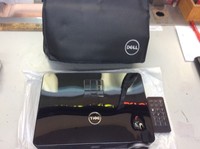About
All feedback (1,292)
- *****- Feedback left by buyer.Past 6 monthsVerified purchaseGreat buyer! A pleasure to do business with.
- ftk1 (777)- Feedback left by buyer.Past 6 monthsVerified purchaseGreat buyer, thank you!
- perfectpair75 (12)- Feedback left by buyer.Past 6 monthsVerified purchaseGreat buyer! Excellent communication, fast payment. Thank you!!
- estebesbrand (48)- Feedback left by buyer.Past yearVerified purchaseQuick payment no issues
- froggyt13 (97)- Feedback left by buyer.Past yearVerified purchaseThank you fast payment enjoy!
- ascendtech (128027)- Feedback left by buyer.More than a year agoVerified purchase*** Thank you for your purchase, come back any time - Ascendtech ***
Reviews (4)

Jul 10, 2017
Good, but...
This projector is a Dell branded version of the Acer K335... but without some of the nice features of the Acer. Dell stripped out the MHL functionality, and a LOT of the image control settings in the menus.
However, Dell has the WiFi functionality built-in (but somewhat restrictive), whereas the Acer requires a USB WiFi dongle to be plugged-in for those capabilities.
Personally, I prefer the Acer over the Dell version for its flexibility and user controls. Also, the Acer has a much nicer remote control that fits your hand... the Dell has a tiny, cheap remote. To balance some of the Dell shortcomings, they do include a nice carrying tote/bag with it, which makes transport nice... though it's a soft case and offers little protection.
Image-wise, the Dell is great, and even usable for home theater... if you don't mind 720p resolution. Both are native 1280x800, but for Video use, they accept 1280x720. Do your research, these small DLP WXGA models (Acer, Dell, Optoma) all use diamond shaped DLP pixels, which means you do not get the super-crisp picture from native 1280x800 resolution fine-detail spreadsheet images. For Video though, this issue is less noticeable.
Brightness is pretty good... significantly better than the Acer K132 series and clones:, Dell M115HD and M110, Optoma ML550 and ML750, Ricoh PJ WXC110, etc.

Apr 03, 2018
There's insufficient user adjustability...
You are limited to the mfr's limits, and they're really ULTRA-conservative. It puts too little charge into the cells, so you can never really know the real capacity. (typical tests 2400mAh cells to about 1500-1600mAh) Charging is limited to either Li-Ion at 4.1V/cell, LiPo at 4.2V/cell, or LiFePo4 at 3.3V/cell. Discharge is as bad... limited to too few choices for discharge termination. Also, it doesn't even include a simple/cheap temperature sensor for charge monitoring, but is equipped with the connector for it. If they want to be "safe", then include the temperature sensor! It charged a fully charged 2p 3.6Ah LiFePo4 pouch-cell pack, and didn't even know it... and it ruined them... almost to the point of bursting (puffed them out extremely tight, busting the pack plastic housing wide open!)

Dec 11, 2015
Of course it's good... it's an FW Bell.
1 of 1 found this helpful I had been in the market for a good portable Gauss meter for a while, but just could not bring myself to go with the commonly found China made units... they may be OK for some uses, but I KNEW that if I got a F.W. Bell unit, it would be good... no guessing or hoping... and it has not disappointed. The ability to measure down to 0.01mTesla / 0.1 Gauss (digital resolution) is pretty nice for a handheld meter. The provided zeroing calibration chamber gives me assurance my reading is not biased in either polarity as well. Likewise the fact that each and every probe has its own calibration factor number is reassuring that my measurements are accurate across a wide-range of measurements, clear up to its 20,000 Gauss / 2Tesla full-scale range.
